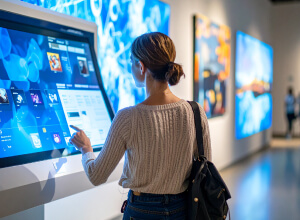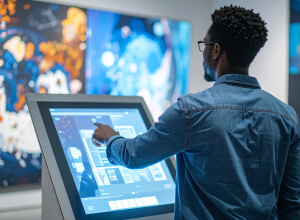Computer Vision For Digital Signage- Applications & Examples

Intuiface explains why computer vision is the next benchmark for digital signage and introduces both computer vision examples and applications.
Intro
History shows that digital signage has come a long way. Throughout a series of technological leaps that have transformed its scope and capabilities, digital signage evolved while reflecting each era in which we live: the society's needs, abilities, and evolution.

Take how it transitioned from being a simple tv-like "display" to today's multifunctional data-driven interactive solution, integrating countless hardware and software options that have gone from attainable to indispensable. The rise of what is now common such as touch, sensors, AI, and data analytics, has dramatically changed the use of digital out-of-home content and led to significant growth in applications across industries over the last few years. Consequently, the solution has been adopted by the places essential to our lifestyle, from banks and malls to airports and museums, very often in ways that make them integral to keeping these places functioning.
What's next for digital signage? For businesses and marketers alike, this question should be as vital as how to stay relevant to survive.
Given the rich technological options and the accelerated advancement of all that we live with today, we can imagine plenty of scenarios. This article will focus on computer vision for digital signage, specifically face analysis for digital signage, for audience measurement purposes. Looking at some applications and computer vision examples, we will demonstrate why this technology deserves to be the next trend catching the eye of digital signage solution providers.
What is Computer Vision? The Next Benchmark for Digital Signage
For a technical solution to go mainstream, it must meet at least four key criteria: affordability, maturity, availability, and of course, demand.
What is computer vision?
A perfect example of how to describe computer vision, is that it's a field of artificial intelligence that enables computers to detect real-world objects and make contextual sense of them, similar to what the human visual system can do.
A simple definition of computer vision from Accenture
Over the last decade, with the evolution of AI and thanks to the effort made by both established and start-up companies, the technology has become more affordable, mature, and available. Today, with deep learning algorithms and simple 2D cameras, computer vision can carry out many sophisticated tasks ranging from eye-movement tracking (e.g., interest analysis based on gaze data) to moving-image classification (e.g., face mask detection) with a fair degree of accuracy.
Meanwhile, the combination of digital signage and computer vision has gained significant attention from early movers amidst their pursuit of more effective and efficient ways to engage with people in a physical space.
The distinctive benefit is the ability to analyze an audience quickly and with high accuracy, enabling the production of highly agile and personalized experiences.
Digital signage as we know it today has long been appreciated for diverse UI options permitting real human-machine exchanges across various methods. It's also not new that it can display personalized content based on users' information and requests.
But the integration of computer vision technology adds the magic of a visual system to the whole - the ability to instantly read and understand unprompted visual input.
When interactive content deployment is combined with the ability to understand audiences, it is much easier for brands and establishments to communicate or take meaningful action in context. This also means deployers can gain useful insight, including who is listening to their message and what content receives more or less attention.
A typical implementation is the analysis of an audience appearing in front of an installation. Without face detection, the scope of attainable audience insight will likely be limited to the onscreen input submitted by a single person, which does not represent everyone in the group. But with computer vision, it becomes possible – without the audiences' effort – to generate the insight mentioned above about every individual or the group as a whole. This enables deployers to embrace a more detailed, data-driven approach in their communication and marketing decisions.
Additionally, digital signage deployers can maximize the benefit of integrating computer vision by taking advantage of advanced data visualization like Intuiface Analytics, enabling the display of meaningful audience information in highly sharable and configurable charts, turning unmanageable data sets into an essential KPI resource.
Computer Vision AI
The digital signage industry is being transformed by computer vision AI. With the help of computer vision artificial intelligence, digital signage can now detect objects, patterns and faces in the environment and respond accordingly. This technology enables digital signage to become more engaging, interactive and efficient than ever before. Personalized experiences and increased customer engagement are just some of the benefits that computer vision AI offers. Moreover, it empowers businesses to display dynamic content on digital signs such as product information, advertisements, and much more. As a result, computer vision AI is revolutionizing the way digital signage is utilized and enhancing its overall impact significantly.
Applications and examples of computer vision with digital signage
1. Demographic-specific content display
With computer vision, identify audience demographic information such as age, gender, or group size, in real-time, and trigger uniquely personalized onscreen content.
Example of Computer vision: Digital Retail - Face Tracking Counter by Waketo
2. Face mask detection
Retailers, banks, hospitals, airports - all have a mask policy and would benefit from automated displays showing Stop/Go messaging based on the detected presence of face coverings. Highly accurate computer vision software such as Sightcorp DeepSight Toolkit can see masks with a high accuracy level for both crowds and individuals.
Example of Computer Vision: Face Mask Detection Experience by Intuiface
(Download free Intuiface Facemask Detection Sample)
3. Entrance Flow Management
Another useful application for the COVID era. Using computer vision, keep track of the entry and exit counts for a venue. By comparing the latest count to venue capacity, enter/wait guidance can be displayed at the entrance. During idle time, advertisements or store information can be shown.
Example of Computer Vision: Entrance Flow Management
(Download free Intuiface Entrance Management Sample)
4. Onscreen content manipulation with head movement
Computer vision is an exciting alternative to touch interaction amidst the concerns about touchscreen cleanliness. Head tracking could be used to indicate a preference. This article explains how to use the Intel distribution of the OpenVINO™ Toolkit, a free Computer Vision solution integrated with Intuiface.
Example of Computer Vision: Intuiface Face Detection with OpenVINO™ - Touchless Interaction





